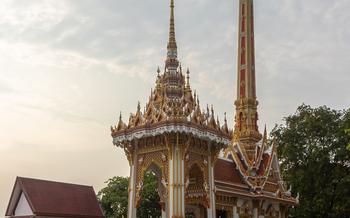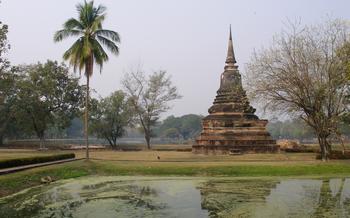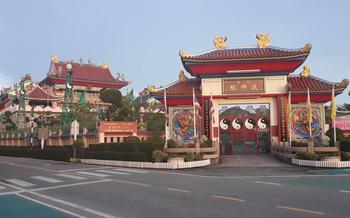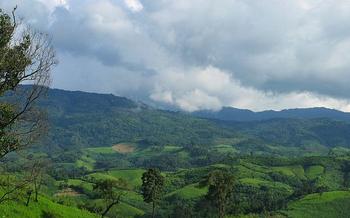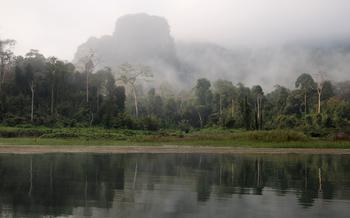
Sao Hai Rice Fields
- Sao Hai Rice Fields: An Overview
- Photography Opportunities
- Cycling and Walking Trails
- Birdwatching Haven
- Local Cuisine
- Homestays and Accommodations
- Sustainable Tourism Practices
- Off-the-Beaten-Path Experiences
- Historical and Cultural Sites
- Local Festivals and Events
- Souvenirs and Handicrafts
- Insider Tip
Sao Hai Rice Fields: An Overview
Nestled in the fertile plains of Saraburi, Thailand, the Sao Hai Rice Fields are a mesmerizing spectacle of nature's bounty. Steeped in history and cultural significance, these rice paddies have been meticulously cultivated for generations, showcasing the harmony between humanity and the environment. The fields stretch across a vast expanse, forming a vibrant tapestry of emerald green, golden hues, and azure skies.
The Sao Hai Rice Fields are conveniently located just a short drive from Saraburi city, making them an easily accessible destination for travelers. The best time to visit these picturesque landscapes is during the rainy season (June to October), when the paddies are brimming with water and the surrounding vegetation is lush and verdant. The entrance to the rice fields is free of charge, allowing visitors to immerse themselves in the tranquil ambiance without any financial burden.
Photography Opportunities
The Sao Hai rice fields are a photographer's paradise, offering an endless canvas of vibrant colors, textures, and compositions. With every turn, you'll discover a new perspective to capture.
Best Spots for Stunning Shots:
Elevated Viewpoints: Climb to higher ground or find a hilltop vantage point to capture sweeping panoramas of the rice fields stretching to the horizon.
Rice Field Reflections: Look for calm waters or ponds that mirror the rice fields, creating stunning reflection shots.
Golden Hour Magic: Plan your visit during the golden hours of sunrise and sunset when the rice fields glow with a warm, ethereal light.
Tips for Memorable Photographs:
Use a Wide-Angle Lens: Capture the vastness of the rice fields with a wide-angle lens to create dramatic compositions.
Experiment with Perspectives: Get creative with your angles and perspectives, shooting from ground level or using a drone for aerial shots.
Focus on Details: Zoom in on the intricate patterns and textures of the rice plants, water droplets, or the faces of local farmers.
Capture the Farmers: Include the local farmers in your shots to add a human element and showcase their hard work.
Patience is Key: Be patient and wait for the right moment, whether it's a flock of birds taking flight or a farmer tending to his fields.
Cycling and Walking Trails
The Sao Hai rice fields are surrounded by a network of well-maintained trails that offer scenic routes for cycling and walking enthusiasts. Whether you prefer a leisurely stroll or an invigorating bike ride, there's a trail for every fitness level and preference.
The trails wind their way through the rice fields, offering panoramic views of the lush green paddies and the surrounding countryside. As you cycle or walk along the trails, you'll encounter traditional wooden bridges, serene ponds, and friendly locals who are always happy to greet visitors.
For those looking for a challenging ride, the outer loop trail provides a more strenuous workout with rolling hills and steeper inclines. The inner loop trail, on the other hand, is ideal for families with young children or those who prefer a more relaxed pace.
No matter which trail you choose, make sure to bring your camera to capture the stunning scenery and the vibrant colors of the rice fields. And don't forget to wear comfortable shoes, as the trails can be uneven in some places.
Birdwatching Haven
The Sao Hai Rice Fields are a haven for bird enthusiasts, offering a rich diversity of bird species that will delight any nature lover. Over 200 species have been recorded in the area, including both resident and migratory birds. The best time for birdwatching is during the cooler months from November to March when migratory birds from Siberia and China seek refuge in the warmer climate of Thailand.
Among the highlights are the critically endangered Sarus Crane, known for its majestic size and distinctive red head, and the elegant Black-necked Stork, with its long, slender bill. Other notable species include the colorful Oriental Pied Hornbill, the Greater Spotted Eagle, and a variety of smaller birds such as sunbirds, warblers, and flycatchers.
The rice fields provide an ideal habitat for these birds, with an abundance of food and shelter. The shallow waters and mudflats are a rich source of insects, snails, and other small creatures, while the rice plants offer perching and nesting sites.
Whether you're a seasoned birdwatcher or simply enjoy observing the beauty of nature, the Sao Hai Rice Fields offer a unique and rewarding experience. Remember to bring your binoculars and a camera to capture the stunning sights and sounds of this avian paradise.
Local Cuisine
Rice is the heart of Thai cuisine, and a visit to the Sao Hai Rice Fields offers a unique opportunity to explore the culinary delights of this staple ingredient. From fragrant jasmine rice to sticky glutinous rice, the variety of rice dishes in the region is astonishing.
One must-try dish is khao pad, a classic fried rice dish that comes in various versions, each with its own unique flavor and ingredients. Another popular dish is som tum, a spicy green papaya salad, often served with sticky rice.
For a truly authentic experience, visit one of the local food stalls or restaurants near the rice fields. Here, you can savor the freshest ingredients, prepared with love and care by local cooks. Be sure to try khao niew mamuang, a sweet and sticky rice dessert with ripe mangoes, or khao tom mat, steamed sticky rice with sweet black beans.
No matter your taste preferences, you're sure to find something to your liking in the culinary offerings of the Sao Hai Rice Fields region. Embrace the opportunity to indulge in the local cuisine and discover the diverse flavors of Thai rice-based dishes.
Homestays and Accommodations
Amidst the verdant landscapes of Sao Hai Rice Fields, visitors have the opportunity to immerse themselves in the local way of life by staying in traditional Thai homestays. These homestays offer a unique chance to live alongside local families, learn about their culture and traditions, and experience the warmth of Thai hospitality firsthand.
One of the highlights of a homestay experience is the chance to savor delicious home-cooked meals prepared using fresh ingredients from the rice fields. Guests can indulge in authentic Thai dishes, often cooked over a traditional wood-fired stove, and learn about the culinary secrets of the region.
Homestays also provide an excellent base for exploring the surrounding area and engaging in various activities. Visitors can join the farmers in their daily tasks, learn about sustainable agriculture practices, and witness the intricate process of rice cultivation.
For those seeking a more conventional accommodation experience, there are several guesthouses and resorts located near the rice fields. These offer a range of amenities and comforts, ensuring a pleasant and memorable stay in this beautiful destination.
Sustainable Tourism Practices
As a responsible traveler, it's essential to minimize your environmental impact while exploring the Sao Hai Rice Fields. Opt for guided tours that prioritize sustainability, using eco-friendly transportation and supporting local conservation efforts. Respect the rice fields and the surrounding environment, avoiding littering, noise pollution, and disturbing wildlife. Choose accommodations that embrace sustainable practices, such as using renewable energy sources, reducing water consumption, and implementing recycling programs. Engage with the local community by learning about their traditional farming methods, participating in workshops, or volunteering your time. Remember, sustainable tourism not only benefits the environment but also ensures that future generations can enjoy the beauty of the Sao Hai Rice Fields.
Off-the-Beaten-Path Experiences
While exploring the Sao Hai Rice Fields, venture beyond the main trails and discover hidden gems that offer unique experiences. One such spot is the Wat Pa Hong Temple, located a short distance from the rice fields. This serene temple, surrounded by lush greenery, is known for its stunning Buddha images and intricate murals depicting scenes from Thai mythology.
For those seeking a unique cultural immersion, consider learning traditional Thai cooking from local villagers. Arrange a cooking class with a local family and immerse yourself in the art of Thai cuisine, using fresh ingredients from the rice fields. Learn to prepare authentic dishes like pad thai and green curry, and take home the recipes to recreate these culinary delights in your own kitchen.
Photography enthusiasts can embark on a sunrise or sunset photoshoot, capturing the magical play of light and shadow across the rice fields. As the sun dips below the horizon, the sky transforms into a canvas of vibrant hues, creating a breathtaking backdrop for your photographs.
For a truly immersive experience, consider volunteering in the rice fields alongside local farmers. Learn about traditional farming practices, assist with daily tasks, and gain insights into the challenges and rewards of rice cultivation. This hands-on experience will give you a deeper understanding of the significance of rice in Thai culture and the dedication of the people who bring this staple food to our tables.
Historical and Cultural Sites
In addition to the scenic rice fields, Saraburi is home to several historical and cultural sites that offer a glimpse into the region's rich past. One of the most notable is the Wat Phra Phutthabat, a Buddhist temple famous for its giant footprint believed to belong to Lord Buddha. The temple complex also houses ancient stupas, shrines, and Buddha images, providing a serene and spiritual ambiance.
Another must-visit site is the Prasat Hin Phimai, a Khmer-style temple complex built in the 11th century. With its well-preserved ruins, intricate carvings, and towering prangs, Prasat Hin Phimai is a testament to the architectural prowess of the ancient Khmer empire.
For those interested in learning more about Saraburi's history, the Saraburi National Museum is a treasure trove of artifacts, exhibits, and information. The museum showcases the province's cultural heritage, from prehistoric times to the present day, providing a deeper understanding of the region's fascinating past.
Exploring these historical and cultural sites not only enriches your visit to the Sao Hai Rice Fields but also offers a comprehensive insight into the diverse heritage and traditions of Saraburi.
Local Festivals and Events
Saraburi comes alive with vibrant festivals and events throughout the year, offering a glimpse into the rich cultural heritage of the region. One of the most significant events is the Sao Hai Rice Planting Festival, held annually in July or August. This colorful festival celebrates the start of the rice-planting season and showcases traditional farming practices, cultural performances, and local delicacies. Visitors can witness the planting of rice seedlings, participate in traditional rituals, and enjoy live music and dance performances.
Another must-attend event is the Saraburi Buffalo Racing Festival, held in October or November. This unique festival features buffalo races, where jockeys guide their water buffaloes through a muddy track, cheered on by enthusiastic spectators. The festival also includes cultural performances, food stalls, and a lively atmosphere.
For those interested in history and culture, the Wat Phra Phutthabat Historical Fair is a must-visit. Held annually in February or March, this fair takes place at the ancient temple of Wat Phra Phutthabat, which houses a sacred footprint of Buddha. The fair features historical reenactments, cultural performances, and traditional handicraft demonstrations, providing a glimpse into the rich past of Saraburi.
Souvenirs and Handicrafts
Local Markets and Shops: For authentic souvenirs and handicrafts, head to the local markets or shops in Saraburi. These markets are a treasure trove of unique items, from handwoven textiles and pottery to intricate wood carvings and silver jewelry. Remember to haggle politely for the best prices, and be sure to support the local artisans by purchasing their products.
Unique Handicrafts: Among the must-buy souvenirs from Saraburi are the intricately designed silver jewelry, featuring traditional Thai motifs and gemstones. The handwoven silk and cotton textiles are also popular, showcasing vibrant colors and intricate patterns. Don't forget to look for unique pottery pieces, often adorned with delicate floral designs or animal figurines.
Supporting Local Artisans: Your purchase of local handicrafts directly supports the talented artisans who create them. By buying these souvenirs, you contribute to the preservation of traditional skills and techniques and help sustain the local economy.
Personal Experience: I stumbled upon a small shop run by a local artisan who specialized in silver jewelry. I was mesmerized by the intricate designs and the sparkle of the gemstones. I ended up buying a beautiful necklace as a souvenir, and I still cherish it as a reminder of my travels in Saraburi.
Insider Tip
Venture beyond the main rice fields and discover a hidden viewpoint that offers a breathtaking panorama of the entire landscape. As the sun dips below the horizon, the sky transforms into a canvas of vibrant hues, casting a golden glow upon the emerald-green fields. It's a moment of tranquility and awe, where you can truly appreciate the beauty and serenity of this hidden gem. Embrace the solitude, let your thoughts wander, and soak in the magic of this special place.
